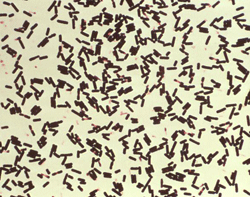Clostridium perfringens
NEW! Tips to Prevent Illness from Clostridium Perfringens
Frequently Asked Questions
What is Clostridium perfringens?
Clostridium perfringens (C. perfringens) is a spore-forming gram-positive bacterium that is found in many environmental sources as well as in the intestines of humans and animals. C. perfringens is commonly found on raw meat and poultry. It can survive in conditions with very little or no oxygen. C. perfringens produces a toxin that causes illness.
How common is C. perfringens food poisoning?
C. perfringens is one of the most common causes of foodborne illness in the United States. It is estimated that it causes nearly a million cases of foodborne illness each year.
What are the symptoms of C. perfringens food poisoning?
Persons infected with C. perfringens develop watery diarrhea and abdominal cramps within 6 to 24 hours (typically 8-12). The illness usually begins suddenly and lasts for less than 24 hours. Persons infected with C. perfringens usually do not have fever or vomiting. The illness is not passed from one person to another.
Who is at risk of C. perfringens food poisoning?
The very young and elderly are most at risk of C. perfringens infection and can experience more severe symptoms that may last for 1-2 weeks. Complications including dehydration may occur in severe cases.
How is C. perfringens infection diagnosed?
Laboratories diagnose C. perfringens food poisoning by detecting a type of bacterial toxin in feces or by tests to determine the number of bacteria in the feces. Because C. perfringens is so common in the environment, the feces of healthy people will commonly contain C. perfringens, so a count of at least 106 C. perfringens spores per gram of stool within 48 hours of when illness began is required to diagnose infection.

Clostridium perfringens bacteria that had been
grown in Schaedler’s broth

Cultures of Clostridium perfringens grown
on an egg yolk agar plate
How is C. perfringens treated?
Oral rehydration or, in severe cases, intravenous fluids and electrolyte replacement can be used to prevent or treat dehydration. Antibiotics are not recommended.
What causes C. perfringens food poisoning?
C. perfringens forms spores that survive high temperatures. During cooling and storage at temperatures from 68°F–140°F (20°C to 60°C) the spores germinate and then the bacteria grow. If the food is served without reheating to kill the bacteria, live bacteria may be eaten. The bacteria produce a toxin inside the intestine that causes illness.
What are common food sources of C. perfringens?
Beef, poultry, gravies, and dried or pre-cooked foods are common sources of C. perfringens infections. C. perfringens infection often occurs when foods are prepared in large quantities and kept warm (20°C to 60°C; 68°C–140°F) for a long time before serving. Outbreaks often happen in institutions such as hospitals, school cafeterias, prisons, and nursing homes, or at events with catered food.
How can C. perfringens food poisoning be prevented?
Foods such as beef, poultry, gravies, and other foods commonly associated with C. perfringens infections should be cooked thoroughly to an internal temperature of at least 145°F-165°F (63°C to 74°C), and then kept at a temperature that is either warmer than 140°F (60°C) or cooler than 41°F (5°C) after cooking. Meat dishes should be served hot right after cooking. Leftovers should be reheated to at least 165°F (74°C) before serving. Leftover foods should be refrigerated as soon they are removed from heating devices and serving tables. Roasts, stews, and similar dishes should be divided into small quantities for refrigeration.
NOTE: This information is not meant to be used for self-diagnosis or as a substitute for consultation with a health care provider. If you have any questions about the disease described above or think that you may have an infection, consult a health care provider.
References:
CDC. Clostridium perfringens Gastroenteritis Associated with Corned Beef Served at St. Patrick's Day Meals -- Ohio and Virginia, 1993. 2004. Morb. Mortal. Weekly Report 43(8): 137-8, 143-4.
Get email updates
To receive email updates about this page, enter your email address:
Contact Us:
- Centers for Disease Control and Prevention
1600 Clifton Rd
Atlanta, GA 30333 - 800-CDC-INFO
(800-232-4636)
TTY: (888) 232-6348
24 Hours/Every Day - cdcinfo@cdc.gov


